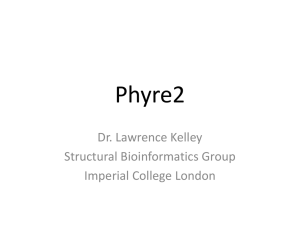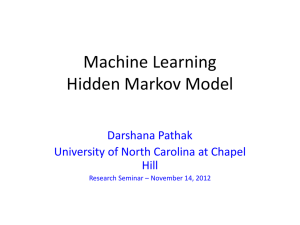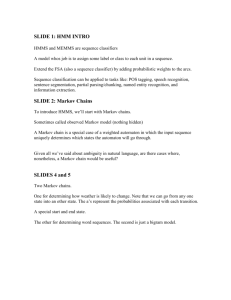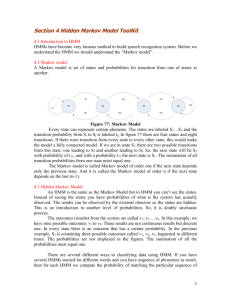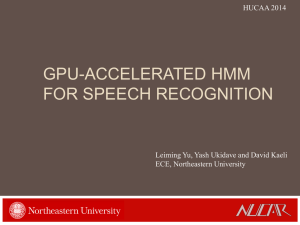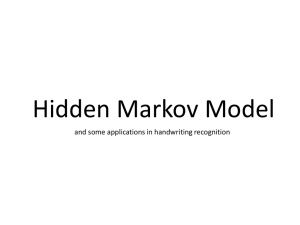HMM-BASED PATTERN DETECTION
advertisement
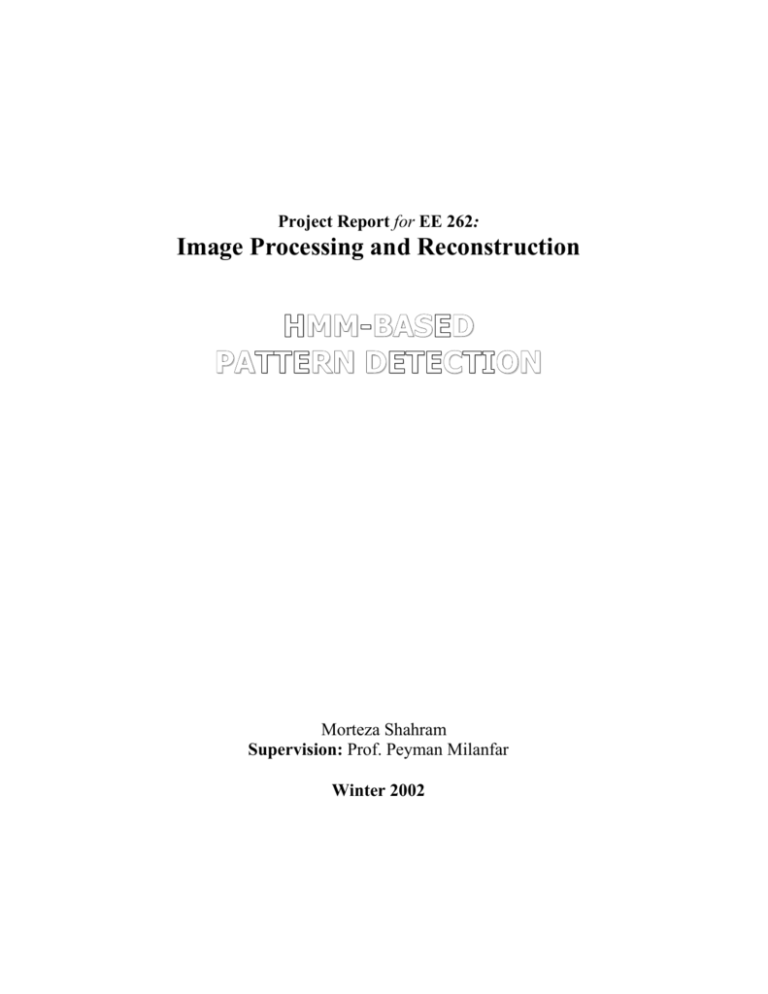
Project Report for EE 262:
Image Processing and Reconstruction
HMM-BASED
PATTERN DETECTION
Morteza Shahram
Supervision: Prof. Peyman Milanfar
Winter 2002
HMM-BASED PATTERN DETECTION
ABSTRACT
Mathematical basis of Hidden Markov Modeling (HMM) are
presented. For the proposed application that is 2-Dimensional
pattern classification, a set of ergodic continuous observation HMMs
were constructed, each of them corresponding to one pattern. To
classify the patterns, particular combinations of 2-D DCT
coefficients have been employed for feature vectors. Forwardbackward algorithm and Vitterbi formulation are explained for
evaluation of models. Initial parameters were estimated via a Kmeans clustering algorithm and then reestimated by EM (Expectation
Modification) algorithm from a multi-observation training set. To
see how well this modeling can help us to successfully detect the
patterns, Learning Vector Quantization and Template Matching were
implemented and compared. The results show that this approach
does not seem hopeful for this application.
I. INTRODUCTION [1]
Signal modeling not only provide the basis for a helpful description of sources that produce
the signals and therefore enable us to simulate the source, but also they often work well in
practice. This possibility enable us significant practical system for signal analysis and
processing. One broad category of signal models is the set of statistical models I which one
tries to characterize only the statistical properties of signal. The necessary assumption here
is that the model can be characterized as a parametric stochastic process and those
parameters can be precisely estimated. Examples of such models include Markov chain and
hidden Markov process that in viewpoint of information theory is interpreted as a Markov
chain viewed through a memoryless noisy channel.
Markov models are very rich statistical models that are widely used in signal and image
classification. Specially, The theory of hidden Markov models (HMM) was developed by
Baum in 1970 and was started to implement for speech processing by Baker. Since they
have been very successful in automatic recognition of speech, this model has earned
increasingly popularity in the last several years.
There have been other fields of interest that HMM are utilized for computational biology,
biomedical signal interpretation and also for image classification, segmentation and
denoising. For example in papers [ , ], HMM structure was applied for image segmentation
that used 2-Dimensioanl structure. This structure actually covers concept of second order
Markovian process.
In this paper, it is tried to implement HMM for a particular application of 2-dimensional
pattern detection. These patterns are acquired through a imaging system with circular
aperture where image of a point is spread by a point spread function. Problem of interest
here is the ability to detect three patterns generated by two points, one point as well as no
point, respectively. Obviously, this problem should be considered with presence of the
noise in all cases.
Organization of this report is as follows: in Part II, the theory of hidden Markov models
will be provided and in the next section, proposed application will be introduced and then
results will be presented. To compare the results with other basic classification, learning
vector quantization and template matching approaches were simulated and the results are
included.
II. HIDDEN MARKOV MODELS
A.
Markov Chains and Extension to Hidden Models [1,2,3]:
A stochastic process is an indexed sequence of random variables. In general, there can be
an arbitrary dependence among the random variables. This process is characterized by the
joint probability mass function. Now, consider a process that can be described at any time
as being in one of a set of N distinct states as illustrated in figure 1 (N=3). At any index of
time, system undergoes a change of state (possibly back to the same state) according to a
set of probabilities.
S2
S3
S1
a31
Figure 1: A Markov chain with 3 states
A full probabilistic description of the above system requires specification of current state
and all previous states. For the special case of first order Markov process this probabilistic
description is truncated to just the current and previous state.
Pqt S j | qt 1 Si , qt 2 Sk ,... Pqt S j | qt 1 Si
aij
(1)
1 i, j N
Where qt is actual state at time t and aij is the transition probability between state i and j.
State transition coefficients have the property
N
a
j 1
ij
1
(2)
The above stochastic process could be called an observable Markov model since the output
of process is the set of states at each instant of time, where each state corresponds to a
physical event. This model is too restrictive to be applicable to many problems of interest.
We can extend the concept of Markov models to include the case where observation is a
probabilistic function of the states. Underlying a HMM is a basic Markov process that is not
observable but can be observed through another set of stochastic sources that produce
observation. In fact HMM is a conditionally independent process or in viewpoint of
information theory is a Markov chain view through a memoryless noisy channel. States
corresponds to clusters of information in “context” that have similar probability
distributions of observation.
B.
Elements of Hidden Markov Models[1]
In order to characterize an HMM completely, following elements are needed.
The number of states of the model, N
The number of distinct obseravtion symbols per state, M
The state transition probability distribution A={aij}
aij P(qt S j | qt 1 Si )
The observation symbol probability distribution ins state j;
b j (k ) P(Vk at t | qt S j )
the initial state distribution
i P(q1 Si )
(3)
(4)
(5)
The model parametres notation: ( A, B, )
Actaullay these parameters are refered to the case when the observation were characterized
as discrete symbols chosen from a finite alphabet and therefore dicstere probability density
could be used. But in practice we mostly deal with contiuous observation signals like as
speech, biological signals and image.hence we have to use HMM with continuous
observation density. The most general representation of the PDF is a finite mixture of
normal distributions with different means and variances for each state.
M
b j (O) C jm(O, jm ,U jm ) 1 j N
m 1
(6)
where Cjm is mixture coefficient for the m’th mixture in state j and is Guassian with mean
jm and covariance matrix Ujm for the m’th mixture component in state j. In following parts
formulation for continuous observation will be presented, too.
C.
Three Fundamental Problems for HMM[1]
There are three problems of interest that must be solved for the model:
Problem 1:Evaluation
Given the observation sequence O=O1 O2 …OT and a model , compute P(O| ), the
probability of the observation sequence, given the model. This problem is evaluation or
scoring problem. If we consider the case in which we are trying to choose among several
models, this solution give us the model which best matches the observation.
Problem 2: Optimization (Decoding)
Given the observation sequences and the model, find the optimal corresponding state
sequence. This is the one that tries to uncover the hidden part of the model. There is no
exact and unique solution for this problem, but in practice, an optimality criterion is
considered to solve the problem. There are several optimality criteria that can be applied.
Problem 3: Training
Estimating model parameters. Some observations sequences used to adjust the model
parameters.
D.
Evaluation Problem[1]
The most straightforward way to find the probability of observation given the model, is
enumerating every possible state sequence of number of observations T. The probability of
the observation sequence for the sate sequence of Q=q1 q2 …qT is
P(O, Q | ) bq1 (O1 )bq 2 (O2 )....bqT (OT )
and the probability of such a state sequence can be written
P(Q | ) q1aq1q 2 aq 2 q 3 ....aqT 1qT
(6)
(7)
So, the probability of observation given the model will be
P(O | )
P(Q | )P(O, Q | )
all Q
(8)
b (O1 )aq1q 2bq 2 (O2 )....aqT 1qT bqT (OT )
q1 q1
all Q
direct calculation of this equation will involve on he order of 2TNT calculations that is
absolutely impossible for practical applications. Fortunately an efficient procedure exists
and is called forward-backward procedure.
Forward-Backward Algorithm[1]
Consider forward variable t(i) defined as
t (i) P(O1O2 ...OT , qt Si | )
(9)
Here is the procedure to compute this variable inductively:
Initialization
1 (i) b j (O1 ) 1 i N
(10)
(11)
Induction
N
t 1 ( j ) t (i)aij b j (Ot 1 ) 1 t T 1
i 1
Termination
N
P(O | ) T (i )
i 1
We see that it requires on the order of N2T calculations.
In similar manner, we can define backward variable as follows:
(12)
t (i) P(Ot 1Ot 2 ...OT | qt Si , )
Again, we can solve for this variable inductively,
Initialization
T (i) 1 1 i N
(13)
(14)
Induction
N
t (i ) b j (Ot 1 ) t 1 ( j )aij 1 t T 1
(15)
i 1
Backward procedure will be used in the solution to problem 3and it is not required for the
solution of problem 1.
E.
Optimization (Decoding) problem [1]
There are several possible was of solving problem 2, the optimal state sequence associated
with given observation. For example one optimality criterion is to choose the states which
are individually most likely. To implement this, define a new variable:
t (i) P(qt Si )
t (i) t (i)
P(O | )
(16)
using this variable, we can solve for individually most likely state at time t:
qt arg max t (i) 1 i N
(17)
but this solution is not perfect solution in case of there be some null transition between the
states and this solution determines the most likely state without regard to the probability of
occurrence of sequences of states.
So, we need to modify the optimality criterion. Following algorithm find the single best
state sequence for the given observation sequence and the model.
Viterrbi Algorithm[1]
The best score along the a single path at time t, which accounts for the first t observations
and ends in state Si can be expressed as follows:
t (i) max P(q1q2 ...qt i, O1O2 ...Ot | )
(18)
The complete procedure for finding the best state sequences follows: ( is the variable that
track the of the argument which maximized)
Initialization:
Recursion
1 (i) ibi (O1 )
1 (i) 0
1 i N
(19)
t (i) max t 1 (i)aij b j (Ot ) 2 t T
t (i) arg max t 1 (i)aij 1 i N
(20,21)
Termination
P* max T (i ) 2 t T
qT arg max T 1 i N
(22,23)
qT t 1 (qt 1 ) t T 1,T 2,...1
(24)
*
Path backtracking
*
*
F. Training problem[1]
There is no known analytical approach to solve the model parameters that maximizes
probability of observation given that model. Here one of the most famous algorithms named
the expectation-modification algorithm is described.
For this algorithm, again, a new variable is defined:
t (i)aijb j (Ot 1 ) t 1 (i)
t (i, j ) P(qt Si , qt 1 S j | O, )
N
N
(i)a b (O
i 1 j 1
t
ij j
t 1
(25)
) t 1 (i )
The reestimation procedure here is as follows:
(26)
i 1 (i )
T 1
aij
(i, j )
t 1
T 1
t
(27)
(i)
t
t 1
T
b j (k )
(i)
(28)
t
t 1, Ot Vk
T
(i)
t 1
t
This procedure will be repeated until convergence of model parameters. This formulation is
for single discrete observation sequence. As it was explained before we have continuous
observation in most of the real-world applications. In addition to this matter, for appropriate
training of the model, we need to feed multi-observation sequences to the reestimation
procedure. The modification for the reestimation procedure is straightforward: suppose we
have the set of K observation of sequences. Therefore we need to maximize the product of
each probability of individual observation given the model instead of the one we saw
before.
K
K
k 1
k 1
P(O | ) P(O ( k ) | ) Pk
that O O (1)O ( 2 ) ...O ( K )
(29)
All of the parameters used for intermediate computation including forward variable and
backward variables will be computed individually for each observation;
t( k ) (i), t( k ) (i), t( k ) (i) .
The final reestimation formulation for ergodic, continuous observation HMM with multiobservation training can be shown this way. The term “ergodic” here refers to this fact that
every state the model could be reached in a single step from every other state (fully
connected HMM).
This formulation is supposed for mixture of Gaussian distribution as PDF of observations.
K
i
k 1
(k )
1
(i )
(29)
k
K
1
P
K
a ij
1
P
k 1
k
1
T
P
k 1
(k )
t
(i )a ij b j (O t( k)1 ) t(k )1 ( j )
k t 1
K
1
T
P
k t 1
T
(k )
t
k t 1
(k )
t
(30)
(i ) t( k ) ( j )
k 1
K
i
1
P
k 1
K
K
i2
1
(k )
t
( j)
k t 1
T
P
k 1
(31)
T
1
P
k 1
( j ).O t( k )
(k )
t
( j ).(O t( k ) i )
k t 1
K
1
T
P
k 1
(32)
(k )
t
( j)
k t 1
In this process Forward and backward variables consist of a large number of terms of a and
b that are generally significantly less than 1. it can be seen as t get big, each term will
exceed precision range of any machine even in double precision. Hence the only reasonable
way of those computations is incorporating a scaling procedure. A detailed description of
scaling can be found in [].
III. APPLICATION
In this paper, it is tried to implement HMM for a particular application of 2-dimensional
pattern detection. These patterns are acquired through an imaging system with circular
aperture where image of a point is spread by a point-spread function. Problem of interest
here is the ability to detect three patterns generated by two points, one point as well as no
point, respectively. Obviously, this problem should be considered with presence of the
noise in all cases. Suppose the point spread function has the form of first order Bessel
function divided by radius. This is kind of 2-D version of sinc function in 1-D case[4].
J (2 x 2 y 2 )
PSF ( x, y ) jinc2 ( x, y ) 1
2
2
x y
(33)
So, measured patterns are in the forms of:
Pattern 1 : W ( x, y )
pattern 2 :
pattern 3 :
jinc 2 x, y W ( x)
(34)
d
d
d
d
jinc 2 x sin( ), y cos( ) jinc 2 x sin( ), y cos( ) W ( x)
2
2
2
2
0 2
where W(x) is supposed to be white Guassian noise. In figure 2, some sample of these
images are shown. The first and second line of figures are the images with SNR=-10 and 5,
respectively. The left, center, and right images are samples of pattern 3, 2 and 1. (d=2)
Figure 2: samples of patterns measured from
two objects, one object and noise (from left to right)
Feature vector
The images that used for application are 16*a6 pixels and DCT coefficient or averages of
absolute value over some of them used as feature as figure (3). This way we have a feature
vector with 13 elements for 16*16 image.
Average of absolute
values of the coefficients
Figure 3: Feature vector built from DCT coefficients
Initial Estimation of HMM parameters
Basically there is no straightforward answer to above question. Choosing either random or
uniform variable for transition matrix may reach the process to convergence in global
minima. But for parameters of observation distribution are really necessary. Random
quantities in this case will hardly converge. For this purpose, K-means clustering algorithm
was used to extract clusters of information from the observation. Detailed description of
this algorithm can be found in related textbooks [5]. Results show that this algorithm gives
really reasonable estimation of parameters.
IV. RESULTS
To see how well this modeling can help us to successfully detect the patterns, Learning
Vector Quantization and Template Matching were implemented and compared. Reader can
refer to major textbooks to find more about learning vector quantization [6]. Basic idea in
vector quantization is constructing some reference vector for each class (pattern, here DCT
coefficients). There is a learning stage for tuning values of this references. In addition of
computing these vectors (centroids), variance of each entry of them are estimated, too. This
estimation allows us to utilize following distance measure that gives us more precise
answer in sense of some statistical criterions. The distance measure between observation O
and k’th centroid Ck with variance of
kt2 for every elements of it will be:
T
Dk
t 1
(ckt oi ) 2
k2
(35)
Training set of both HMM and LVQ were same And there have been created 5
representative (centroid) for each pattern for LVQ stage.
The results is shown in figures (4). In right side of figure 4, we see the detection error rate
vs. SNR for three different values of “d”. The results for d=1 and d=2 are very close to each
other that it could be predicted.
In left side, results for mentioned methods are depicted and states unsuccessful behavior of
HMM for this specific problem. LVQ has worked much better than HMM.
It will be fine to investigate the reason of high error rate of detection for hidden Markov
modeling. Possible reasons can be mentioned as insufficient training, convergence to local
minima, inappropriate feature vector used in this problem or even intrinsic limitation of
HMM for this problem.
figure 4: detection error for HMM, LVQ and template matching (right)
HMM result for three different values of d
REFERENCES
[1] L.R. Rabiner “ A Tutorial on Hidden Markov Models and Selected applications in
speech recognition” Proceeding of the IEEE, Vol. 77, No 2, Feb 1989
[2] Thomas Cover and joe Thomas “Elements of Information Theory” ?
[3] J. Li, A. Najmi and R. Gray “Image Classification by a Two-Dimensional Hidden
Markov Model” IEEE Transaction on Image Processing Vol 48, No 2, Feb 2000
[4] Goodman “Fourier Optics?” ? McGarw Hill
[5] Gonzales and Witz “Pattern Recognition” Prentice Hall International ?
[6] Gray and Gersho “Signal Compression and Vector Quantization”, Kluwer Academic
Publication ?

